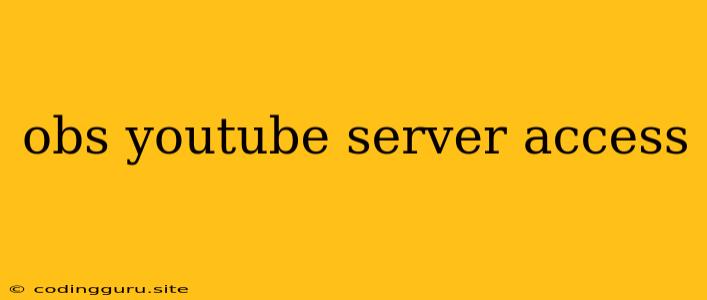OBS and YouTube: Mastering the Stream Setup
Want to broadcast your gaming sessions, share your creative projects, or just chat with your audience live? OBS (Open Broadcaster Software) and YouTube are a powerful combination for achieving your streaming goals. But setting everything up can seem daunting at first. This article will guide you through the process of connecting OBS with YouTube, ensuring your streams are smooth and successful.
Understanding the Connection: OBS and YouTube
OBS is a free and open-source software that allows you to capture and mix video, audio, and other sources, creating a professional-looking stream. It's highly customizable and provides a wide range of features, making it the go-to choice for many streamers.
YouTube is the world's largest video-sharing platform, offering an intuitive and user-friendly environment for live streaming. It provides a dedicated live streaming platform that integrates well with tools like OBS.
The Steps to Connecting OBS to YouTube: A Breakdown
1. Setting Up Your YouTube Channel for Live Streaming
- Enabling Live Streaming: Navigate to your YouTube channel's Creator Studio. Under the "Live Streaming" section, ensure that you've enabled the feature.
- Creating a Stream: Click on the "Create" button in the YouTube Studio, select "Live Stream," and create a new stream. You'll need to give your stream a title, set a start time, and choose a privacy setting (public, private, or unlisted).
2. Configuring OBS for YouTube Streaming
- Choosing the Right Settings: Open OBS and go to the "Settings" menu. Under the "Output" section, select "Streaming."
- Choosing YouTube as Your Streaming Platform: Click on the dropdown menu next to "Streaming Service" and select "YouTube."
- Finding Your YouTube Stream Key: Go back to your YouTube Live Stream setup. You'll find your unique stream key, which is essential for connecting OBS to your YouTube channel.
- Inputting the Stream Key in OBS: Copy your stream key from YouTube and paste it into the designated field in OBS under "Streaming" settings.
- Customizing Video and Audio Settings: Adjust the video resolution, frame rate, and bitrate in OBS to match your YouTube stream settings. Experiment with different audio settings for optimal clarity.
3. Testing Your Connection
- Running a Test Stream: It's highly recommended to perform a test stream before your live broadcast. This allows you to ensure that everything is set up correctly and that your stream looks and sounds good.
- Monitoring Your Stream: While testing, check your YouTube live stream dashboard to monitor the stream quality and identify any potential issues.
- Resolving Issues: If you encounter any problems during your test stream, double-check your OBS and YouTube settings for any errors.
4. Going Live
- Preparing for Your Stream: Before you start your live stream, ensure that your microphone, camera, and other equipment are working properly.
- Starting the Broadcast: In OBS, click on the "Start Streaming" button to initiate your YouTube live stream.
- Interacting with Your Audience: Use YouTube's live chat feature to engage with your viewers and create a more interactive streaming experience.
- Ending Your Stream: When you're ready to finish your stream, simply click on the "Stop Streaming" button in OBS.
Troubleshooting: Common Issues and Solutions
- "Stream key invalid" error: Double-check that your stream key is correct and that you've pasted it accurately into OBS.
- "Cannot connect to YouTube" error: Ensure you have a stable internet connection and that your firewall isn't blocking OBS from accessing YouTube.
- Poor Stream Quality: Check your internet upload speed and adjust the bitrate in OBS to optimize your stream quality.
Tips for Stream Optimization
- Invest in a Quality Microphone: A good microphone will significantly improve your stream's audio quality, making it more enjoyable for your viewers.
- Use a Lighting Setup: Proper lighting will make you appear more professional and will enhance the visual quality of your stream.
- Be Creative with Scene Transitions: Use OBS's scene transitions to add visual flair to your stream, keeping your audience engaged.
- Leverage Overlay Templates: There are many free and paid overlay templates available online that you can use to customize your stream's appearance.
- Use a Webcam: A webcam will enable you to interact with your audience directly and build a stronger connection.
Conclusion
Connecting OBS with YouTube for live streaming is a simple process with a bit of setup. By following the steps outlined above, you can successfully broadcast your content and reach a wider audience. Don't be afraid to experiment with different settings and configurations to find the best setup for your needs. Remember, consistency is key. Regular streaming will help you grow your audience and build a loyal following. Enjoy the journey!
